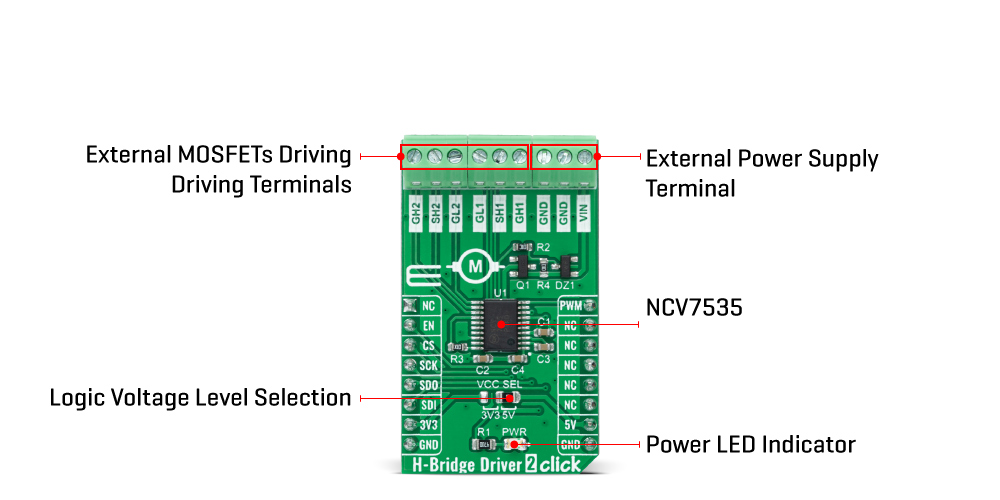






Overview
The H-Bridge Driver 2 Click Board™ is a compact add-on board that contains an H-bridge gate driver, also known as a full-bridge pre-driver. This board features the NCV7535, a monolithic H−bridge pre-driver for a DC motor with an enhanced feature set, useful in automotive systems from ON Semiconductor. The gate driver channels are independently controlled by a 24-bit SPI interface, allowing this Click board™ to be optionally configured in a single or dual H-bridge mode. It has a wide operating voltage range from 6V to 18V with built-in protection features against short-circuit, under/over voltage, overcurrent, and overtemperature conditions. This Click board™ is suitable to drive external MOSFETs, thus providing control of a DC-motor.
The H-Bridge Driver 2 Click Board™ is supported by a mikroSDK compliant library, which includes functions that simplify software development. This Click board™ comes as a fully tested product, ready to be used on a system equipped with the mikroBUS™ socket.
Downloads
How Does The H-Bridge Driver 2 Click Board™ Work?
The H-Bridge Driver 2 Click Board™ as its foundation uses the NCV7535, H-bridge gate driver (or full-bridge pre-driver) with independent high and low-side driver channels from ON Semiconductor. This monolithic H−bridge pre-driver has an enhanced feature set helpful in various applications for a DC motor drive. It allows bi-directional or uni-directional motor operations, with integrated MOSFET and load protection.

The onboard VIN terminal is the device's power supply input, allowing a wide operating voltage range from 6V to 18V. The NCV7535 also comes with built-in protection features against short-circuit and overtemperature conditions, under-voltage (UV), overvoltage (OV), and overcurrent events. When the supply returns to a level above the UV threshold or below the OV threshold, the device resumes regular operation according to the established condition of the input pins.
The H-Bridge Driver 2 Click Board™ communicates with MCU through a standard SPI interface supporting the common SPI mode, SPI Mode 0, providing data in digital format of 24-bits. It also uses the Enable pin labelled as EN and routed to the RST pin of the mikroBUS™ socket to optimize power consumption, used for its power ON/OFF purposes. Besides, by using the PWM signal from the mikroBUS™ socket, combined with the SPI interface and its control register, the user can also use active or passive free-wheeling bridge configurations.
The H-Bridge Driver 2 Click Board™ can operate with both 3.3V and 5V logic voltage levels selected via the VCC SEL jumper. This way, it is allowed for both 3.3V and 5V capable MCUs to use the communication lines properly. However, the Click board™ comes equipped with a library containing easy-to-use functions and an example code that can be used, as a reference, for further development.
SPECIFICATIONS
| Type | Brushed |
| Applications | The H-Bridge Driver 2 Click Board™ can be used to drive external MOSFETs, thus providing control of a DC-motor |
| On-board modules | NCV7535 - H-bridge gate driver (or full-bridge pre-driver) with independent high and low-side driver channels from ON Semiconductor |
| Key Features | Active and standby operating modes, active/passive free-wheeling, single or dual H-bridge mode, 24-bit SPI interface, UVLO and OVLO, protection features, PWM, and more |
| Interface | PWM,SPI |
| Compatibility | mikroBUS |
| Click board size | M (42.9 x 25.4 mm) |
| Input Voltage | 3.3V or 5V |
PINOUT DIAGRAM
This table shows how the pinout of the H-Bridge Driver 2 Click Board™ corresponds to the pinout on the mikroBUS™ socket (the latter shown in the two middle columns).
| Notes | Pin |  |
Pin | Notes | |||
|---|---|---|---|---|---|---|---|
| NC | 1 | AN | PWM | 16 | PWM | PWM Signal | |
| Enable | EN | 2 | RST | INT | 15 | NC | |
| SPI Chip Select | CS | 3 | CS | RX | 14 | NC | |
| SPI Clock | SCK | 4 | SCK | TX | 13 | NC | |
| SPI Data OUT | SDO | 5 | MISO | SCL | 12 | NC | |
| SPI Data IN | SDI | 6 | MOSI | SDA | 11 | NC | |
| Power Supply | 3.3V | 7 | 3.3V | 5V | 10 | 5V | Power Supply |
| Ground | GND | 8 | GND | GND | 9 | GND | Ground |
ONBOARD SETTINGS AND INDICATORS
| Label | Name | Default | Description |
|---|---|---|---|
| LD1 | PWR | - | Power LED Indicator |
| JP1 | VCC SEL | Right | Logic Level Voltage Selection 3V3/5V: Left position 3V3, Right position 5V |
H-BRIDGE DRIVER 2 CLICK ELECTRICAL SPECIFICATIONS
| Description | Min | Typ | Max | Unit |
|---|---|---|---|---|
| Supply Voltage | 3.3 | - | 5 | V |
| External Power Supply | 6 | - | 18 | V |
| Operating Temperature Range | -40 | +25 | +85 | °C |
| General Information | |
|---|---|
Part Number (SKU) |
MIKROE-4931
|
Manufacturer |
|
| Physical and Mechanical | |
Weight |
0.02 kg
|
| Other | |
Country of Origin |
|
HS Code Customs Tariff code
|
|
EAN |
8606027389573
|
Warranty |
|
Frequently Asked Questions
Have a Question?
Be the first to ask a question about this.







